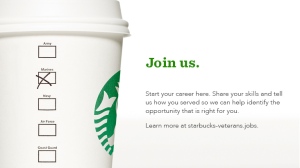Starbucks announced this morning that it will offer an incredibly generous tuition reimbursement plan for its partners (employees) who work an average of 20 or more hours per week in one of their more than 8,500 company operated stores.
Starbucks partnered with Arizona State University (ASU), which offers more than 40 undergraduate degree programs online including electrical engineering, global logistics management, health sciences, information technology, nursing, operations management, organizational leadership, software engineering, criminal justice and criminology and technological entrepreneurship and management. Starbucks partners have no obligation to stay with Starbucks past graduation.
For eligible partners who are admitted to ASU as a junior or senior, Starbucks will provide full tuition reimbursement to allow them to complete their degrees. Those admitted as freshman or sophomores will receive a partial tuition scholarship and need-based financial aid for two years of full time study.
Starbucks has broken the mold before when it comes to how they treat their employees. Partners working an average of 20 or more hours per week receive access to a wide range of benefits that in most companies (and particularly, many retailers) would only be available to  those working full time (40 hours). To add the tuition plan to the benefits package really changes the game when it comes to attracting and retaining quality people in general and veterans in particular.
those working full time (40 hours). To add the tuition plan to the benefits package really changes the game when it comes to attracting and retaining quality people in general and veterans in particular.
Starbucks has a military veteran and military spouse recruiting program. Last November it committed to hiring 10,000 veterans and military spouses over the next 5 years. I think the addition of the tuition reimbursement benefit for degrees obtained through ASU could significantly boost their ability to attract transitioning military, veterans and military spouses for the following reasons:
- Many veterans who transition directly to college out of the military soon find out that the Post 9/11 GI Bill, while very generous, does not cover all of the non-study related expenses like housing, childcare and transportation. So, many student veterans find that they need at least a part time job while in school to cover those additional expenses. Starbucks’ tuition reimbursement program applies to employees who work an average of 20 hours a week, making this the perfect blend (pun intended) of hours committed to work and school.
- ASU is already considered to be a “military friendly” school in that it offers the Yellow Ribbon program, which covers the gap between in-state and out-of-state tuition, it has the Pat Tillman Veterans Center to support student veterans, and it offers the Tillman Military Scholars program which helps to cover other financial gaps experienced by student veterans (a non-traditional student body) such as housing and childcare expenses. There are lots of colleges that offer online degrees, but not all are as supportive of the needs of their student veteran population, so Starbucks selected a perfect partner in ASU.
- The Post 9/11 GI Bill benefit is transferrable to military spouses or children, so if the veteran is hired by Starbucks and, through the ASU tuition reimbursement program, does not need to use their entire GI Bill benefit, they can transfer the unused portion to the spouse or child. Double win for that military family!
- The Post 9/11 GI Bill benefit can be used for undergraduate or graduate programs. So, if the veteran hired by Starbucks completes their undergraduate degree through the ASU tuition reimbursement program, they will have benefit left over to use toward a graduate degree later.
Since there are still too many employers that are less enthusiastic to hire veterans who do not have a bachelor’s degree, I wonder what those employers would be willing to do to fix that situation. Starbucks’ program is not specifically for veterans, but because it exists it can significantly improve their ability to attract veterans and military spouses. Are other employers willing to offer scholarships, internships, work/study arrangements to support student veterans and military spouses?
What do you think? What challenges and benefits do you see with this model (in general) and its potential for veteran recruiting specifically? Post your comments below!
